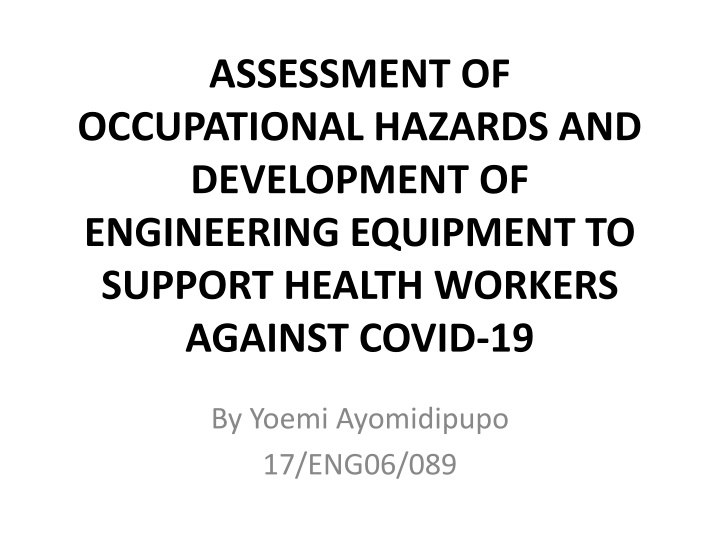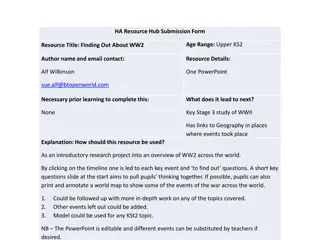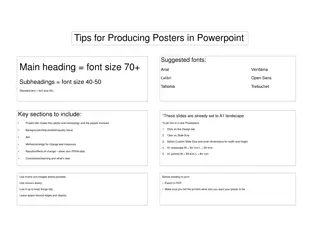
Preventing COVID-19 Hazards: Engineering Solutions for Health Workers
Explore occupational hazards, specifically related to COVID-19, and the development of engineering equipment to protect and support health workers. Get insights into the risks, symptoms, and preventive measures associated with the pandemic.
Download Presentation

Please find below an Image/Link to download the presentation.
The content on the website is provided AS IS for your information and personal use only. It may not be sold, licensed, or shared on other websites without obtaining consent from the author. If you encounter any issues during the download, it is possible that the publisher has removed the file from their server.
You are allowed to download the files provided on this website for personal or commercial use, subject to the condition that they are used lawfully. All files are the property of their respective owners.
The content on the website is provided AS IS for your information and personal use only. It may not be sold, licensed, or shared on other websites without obtaining consent from the author.
E N D
Presentation Transcript
ASSESSMENT OF OCCUPATIONAL HAZARDS AND DEVELOPMENT OF ENGINEERING EQUIPMENT TO SUPPORT HEALTH WORKERS AGAINST COVID-19 By Yoemi Ayomidipupo 17/ENG06/089
HEALTH WORKERS A health worker is one who delivers care and services to the sick and ailing either directly as doctors and nurses or indirectly as aides, helpers, laboratory even medical waste handlers. There are approximately 59 million healthcare workers worldwide. technicians, or
THE CORONA VIRUS (COVID-19) The 2019 20 coronavirus going pandemic of the corona virus disease (COVID-19), caused by severe acute syndrome coronavirus 2 (SARS-CoV-2). The outbreak started in Wuhan Hubei province, China, in December 2019. The World Health Organization(WHO) declared the outbreak to be a Public Health Emergency of International Concern on 30 January 2020 and recognized it as a pandemic on 11 March 2020. As of 8 April 2020, approximately 1.44 million cases of COVID- 19 have been reported territories, resulting in approximately 83,400 deaths. About 308,000 people have recovered. pandemic is an on- in 209 countries and
COVID 19 The virus is mainly spread during close contact and by small droplets produced when those infected cough, sneeze or talk. These droplets may also be produced during breathing; however, they rapidly fall to the ground or surfaces and are not generally spread through distances. People may also become infected by touching a contaminated surface and then their face. The virus can survive on surfaces for up to 72 hours. It is most contagious during the first three days after onset of symptoms, although spread may be possible before symptoms appear and in later stages of the disease. the air over large
COVID-19 Common symptoms include fever, cough and shortness of breath. Complications may include pneumonia and acute respiratory distress syndrome. The time from exposure to onset of symptoms is typically around five days, but may range from two to 14 days. There is no known vaccine or specific antiviral treatment. Primary treatment is symptomatic and supportive therapy. Recommended preventive measures include hand washing, covering one's mouth when coughing, maintaining distance from other people, and monitoring and self-isolation for people who suspect they are worldwide have responded restrictions, quarantines, controls, and facility closures. infected. implementing workplace Authorities travel hazard by curfews,
OCCUPATIONAL HAZARDS Occupational hazard as a term signifies both long- term and short-term risks associated with the workplace environment and is a field of study within occupational safety and health and public health. An occupational hazard is a hazard experienced in the workplace. Occupational hazards can encompass many including chemical hazards, biological hazards (biohazards), psychosocial hazards, and physical hazards types of hazards,
OCCUPATION HAZRDS FACED BY HEALTH WORKERS For the sake of this study, we shall limit these types of hazards to the hazards faced by health workers tackling COVID-19. In the battle against the virus, health workers are exposed to The virus itself Being agents of spread themselves Other occupational hazard ie falls, injury etc.
ENGINEERING EQUIPMENT Equipment most commonly refers to a set of tools or other objects commonly used to achieve a particular Different jobs require different kinds of equipment This refers to the tools or set of tools and/or other objects used to achieve engineering objectives. objective.
HOW ENGINEERING TECHNOLOGIES SUPPORT HEALTH WORKERS Engineering emerging technologies could aid health workers in many ways including the eight listed below Remote Healthcare Prevention Measure Diagnostic Solution Hospital Care Public safety during pandemic
HOW ENGINEERING TECHNOLOGIES SUPPORT HEALTH WORKERS Industry Adapting To The Lockdown Cities Adapting To The Lockdown Individuals Adapting To The Lockdown
REMOTE HEALTHCARE Remote patient monitoring speeds up testing for the infection, followed by tracing and isolating potential carriers. Analysing behavioural and biometric data from wearable improves the accuracy of detecting positive cases of COVID-19. With public health experts reiterating the need for social distancing, nursing and telemedicine applications fill the gap created by a shortage of medical professionals. Connected health platforms allow doctors and patients to remotely engage via interfaces and digital medical assistance. tele- online conversational
Below are 6 of the most relevant engineering solutions that enable a faster and more efficient response to the COVID-19 pandemic in the fields of: Remote Monitoring Telehealth Respiratory Monitoring Digital Stethoscope Mental Health Chat bots Wearable Sensors
Prevention Measure Inside hospitals, doctors, nurses, and health staff use interactive real-time mobile apps to stay updated about infected patients and their treatment. Face masks are essential for ensuring that health workers face minimal risk of contracting the virus while performing their jobs. There is already great pressure on manufacturers of antiviral soaps and sanitizers to produce sufficient numbers in order to keep prices in check
Engineering equipment that operate in the following fields could be used Disease Surveillance Air Filtration Systems Auto-Disinfectants Spit Disposal Antiviral Masks
Diagnostic Solution The WHO urges all health authorities to test, detect, trace, and isolate those found coronavirus. Home testing and diagnostic kits are essential to slow the spread of the virus. When large-scale quarantine measures are in place, virtual care, and interactive patient engagement platforms allow people to obey the measures imposed. Chatbots and symptom checking mobile apps dispense information swiftly and in interesting ways. Contactless temperature reading guns ensure front line responders are not at risk. to have contracted the virtual medical visits,
Hospital Care Hospitals support outcomes. Artificial ventilators and bed-side health analytics significantly improve patient management. Nurses and doctors working on the front lines require safety goggles, gowns, gloves, shields, and surgical-grade include blood testing kits and devices for monitoring respiratory rate, oxygen saturation, and for efficiently testing stool samples. require to focused achieve preparation intended and patient essentials. These
Hospital Care Robots that navigate inside hospitals transport essential tools and medications free up time for nurses to focus on their essential tasks. 3D Printed Ventilator Valve Artificial Cough Device AI Algorithms For Patient Monitoring Anti-Pathogen Fabric Could be of service
Public safety during pandemic AI-based representations, and simulations of any potential outbreak are powerful tools to inform the public about their safety during an epidemic. Technologies to track the mobility of infected cases and robotic disinfection systems help minimize the risk of the virus spreading to frontline workers. Specialized isolation units complement public health systems when hospitals reach their capacity. Doctors and nurses use mobile apps to manage stress and to have effective downtime. and predictive analytics, visual
Public safety during pandemic Drone-based Delivery of Medical Supplies Specialized Isolation Units Mobile Support Workers Visualization & Outbreaks Robots for Patrolling & Disinfecting Can ensure public safety. Applications for Health Prediction of Epidemic
Industry Adapting To The Lockdown For factories and businesses, lockdown situations present extreme challenges and Fitting sensors to track their entire supply chain enables factories to plan production targets. With most people required to stay indoors, vehicles and drones potentially fill the gaps of moving items around a factory floor. Critical components and machines in a factory use expert-assisted augmented reality (AR) to facilitate a reduction in the number of workers required inside a factory. Overall, factories that digitize, across their supply chains, remain better prepared to deal with and prepare for unexpected events, like the coronavirus pandemic. result in heavy losses. automated guided
Cities Adapting To The Lockdown Image and video analytics play an important role in helping cities manage and handle the challenges posed by the pandemic and the resulting lockdown. With billions of people living under forced quarantine, some hospitals and governments use geofencing techniques to ensure infected people obey the restrictions. Mobile applications update with interactive maps and engage with the public about other policy issues. Off-site construction and urban farming potentially play an important role in ensuring temporary structures and basic food supply to cities. With grocery and other essential retail stores under risk of having an outbreak outlets help people manage lockdowns in big cities. citizens about outbreaks self-checkout and cashier-less
Cities Adapting To The Lockdown Smart Surveillance Location-Based Systems Online Civic Services Indoor Farming Autonomous Stores Prefabricated & Modular Construction Sickness Mapping Can aid a city adapt to the lockdown
Individuals Adapting To The Lockdown Mobile and smartphone-based applications are being used to connect with loved ones during these testing times. Some schools are already using e-learning platforms to complete their syllabus for this academic year or term. Offices, forced to temporarily close, are finding innovative online tools to connect and collaborate with their employees. Even before the outbreak, streaming and entertainment apps on smartphones were useful for passing time. By making it easier to practice social distancing and self-isolation, technology enables people to normally carry on their lives, as much as is possible during a lockdown.
Individuals Adapting To The Lockdown Shared Streaming & Entertainment Remote Work Loneliness Management Stress & Anxiety Reduction Online Learning Online Food & Grocery Delivery Indoor Workouts Aid an individual adapt to the lockdown






















